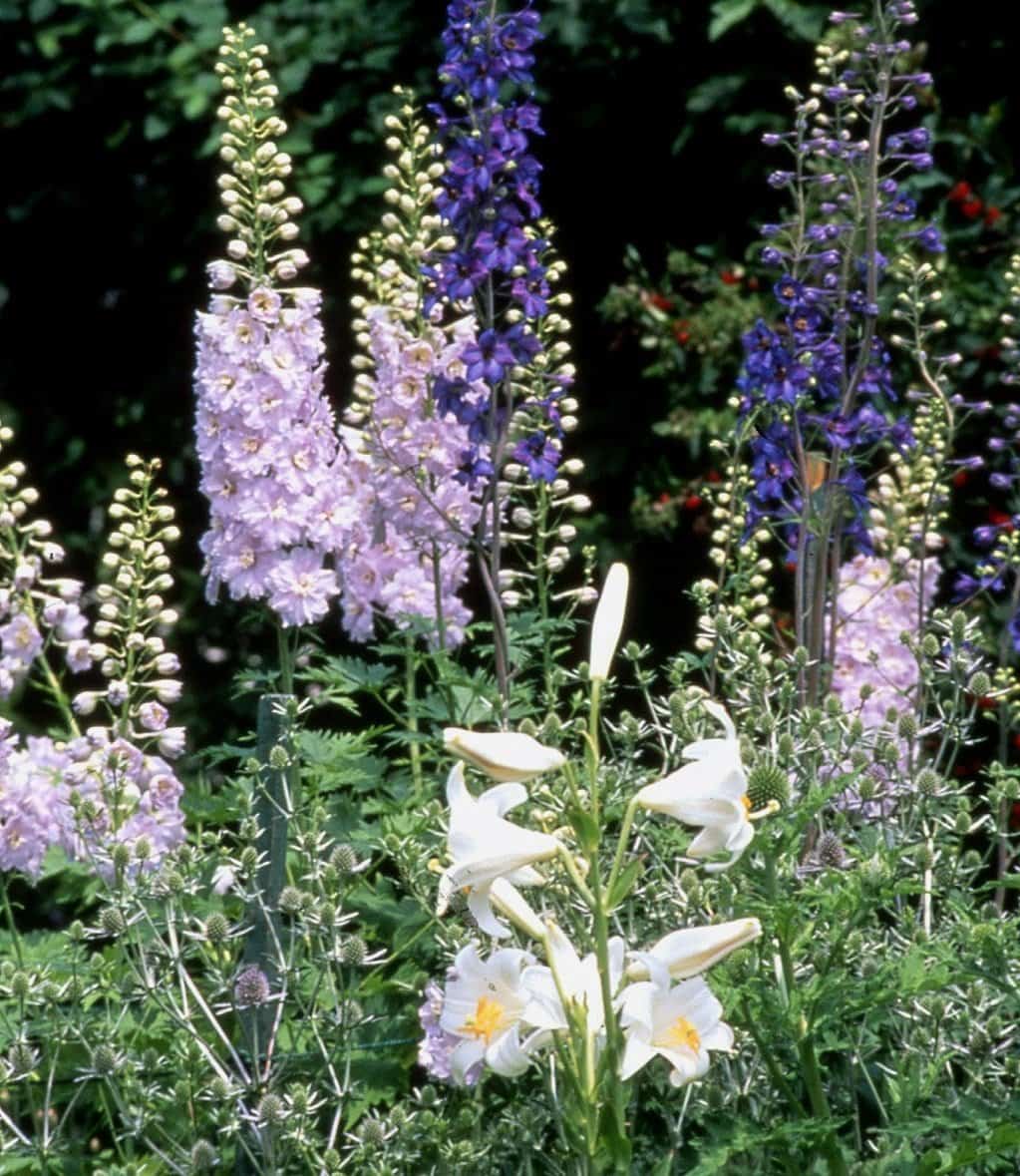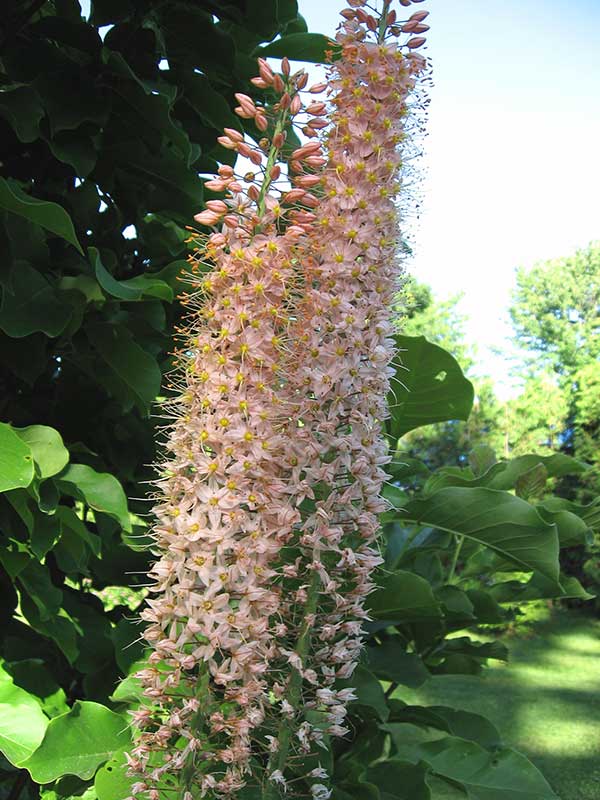
Over the years, I’ve grown a lot of skyscraper flowers — primarily for their beauty, but also because they’re so useful for dramatic accents, focal points and floral screens. And when tall perennials are planted along the margins of small gardens, their height makes the overall space appear larger than it actually is. Hollyhocks, delphiniums, elecampane and spotted Joe Pye weed are a few of my favourite “green tower” flowers, but currently, the less familiar foxtail lily sits comfortably atop my go-to list of mile-high perennials.

Foxtail lily (Eremurus spp. and cvs.)
Lofty perennials by anyone’s standards, several species of foxtail lily produce flowering spikes up to nine feet (2.75 m) tall, and even the shortest of the “dwarf hybrids” tops three feet (90 cm). All bear staggeringly beautiful racemes of flowers — thousands per inflorescence — in pastel shades of white, pink and pale yellow as well as fiery oranges and rich, rusty golds.
Essentially Asian alpines, the first foxtail lily (E. spectabilis) to reach the West was discovered in the Caucasus Mountains in 1810. For the rest of the 19th century, other Eremurus species found their way to Europe via plant hunters, clerics and explorers, and today, botanists recognize about 45 different species. Not a true lily, the genus Eremurus belongs to the Xanthorrhoeaceae family, and its closest relatives include aloes and red hot pokers (Kniphofia spp.), while phormiums and daylilies are more distantly related.
By the late 1800s, a number of gardening enthusiasts had begun to cross different Eremurus species. The most successful of these was Sir Michael Foster (1836-1907), chair of physiology at the University of Cambridge in England. By crossing E. olgae with the narrow-leaved foxtail lily (E. stenophyllus), he developed a new race of cultivars he named E. ×isabellinus, after his wife, Isabelle. These plants were released in 1902 and became known as the Shelford Hybrids. Growing four feet (1.25 m) tall in a wide range of colours, they became immediately popular and remained garden mainstays for the next 50 years.
Then, in the late 1940s, a Dutch breeder named N.C. Ruiter began to re-cross the Shelford clones, eventually releasing his own cultivars in the 1950s — the Ruiter Hybrids — which continue to be the most commonly cultivated foxtail lilies worldwide.
Considered by some to be difficult plants, foxtail lilies aren’t particularly fussy as long as you provide them with the conditions they require. In their natural alpine settings, they experience wet springs followed by dry summers in soils that drain quickly and efficiently. Adding a dry winter mulch of shredded leaves and/or straw will protect the plant’s crowns from fluctuating winter temperatures.
Because foxtail lilies bloom in early summer and prefer to stay dry after flowering, it’s important to surround them with other drought-tolerant plants — mine are paired with spiky, midsummer-blooming Rocky Mountain blazing star (Liatris ligulistylis, Zone 3) and ground-hugging purple portulacas. But plenty of other plants also make excellent companions. Garden writer E.A. Bowles (1865-1954) favoured baby’s breath (Gypsophila paniculata) underplanted with autumn crocuses, while Graham Stuart Thomas (1909-2003) recommended tube clematis (Clematis heracleifolia) and catmint (Nepeta ×faassenii cvs.). And while I’m name-dropping, I should add that in 1951 Vita Sackville-West (1892-1962) wrote “Aristocrats of the garden, they are well worth the three half-crowns they cost.”
The octopus-like roots of Eremurus may be planted in early spring or in autumn (you can order them with your tulips and daffs), and in the summer of Canada’s 150th, gardeners can expect to pay between $7 and $20 per plant — depending on the variety.
My favourite Eremurus species is the Himalayan foxtail lily (E. himalaicus, Zone 5) which grows six feet (1.8 m) tall and bears fragrant white flowers with orange stamens. Introduced from Kashmir to the West in 1881, it’s usually the first Eremurus to flower in Canadian gardens, and I have fond memories of its soaring flower spikes in my childhood garden in Srinagar.
I also adore the giant foxtail lily (E. robustus, Zone 5), which can grow up to nine feet (2.75 m) tall and bears clear pink flowers with yellow stamens (introduced in 1874). And if “nine feet tall” sounds too intimidating, there’s always the four-foot (1.25-m)-tall hybrid ‘Romance’ with pale salmon-pink flowers that fade to a rich cream colour.
Share your comments
Do you grow any skyscraper flowers in your Canada 150 garden?


Caroline , your problem could be that your mulch is too deep ,applied too early or both . Its commonly known that in the cool , damp fall period , plant root area is increased in volume to nourish the coming early increase in top growth . Big roots first will then produce an increase in the top. . Most people don’t realize the volume of air needed by roots to function properly . Experienced gardeners never tramp the soil around a plant especially a newly planted one . By not compacting the soil to any excessive degree , water & air are allowed to infiltrate the soil to the betterment of both the plant & the soil . No more than 2 1/2 in. of mulch & a covering of evergreen boughs , [ discarded Xmas trees } , is the ideal plant protection method . Of course a well drained soil is an absolute before any planting begins . Perhaps a test planting of other , more hardy perennials who hate their roots in a wet situation could be tried first .
Hi
I love Eremurus but have stopped selling them. I live in Toronto and every spring when I think I have success for I see the plants are alive they end up with “crown rot” even with tonnes (2 ft) of mulch for protection. It is the cold snaps at night or sometimes end of March early April we get a week of below 0 temperatures. You really need an ideal location. Some customers north of the city where the ground stays frozen longer come spring have much better success. Oh how I wish I could have foxtail lilies in my garden
I couldn’t agree with you more Caroline. I never had much luck with Eremurus in my Toronto garden (wet, heavy clay soil coupled with unreliable snow cover in winter). And although I now garden in a much cooler Zone 5a (as opposed to 6b), I find I can grow a wider range of plants than I ever could in T.O.
I’m convinced that it’s due to cooler temperatures and reliable snow cover over the winter months. Every zone has its pros and cons. Great to hear from you–! All best, Stephen
I’ve seen 6 foot high Foxtail Lilies that are divided in colours of Yellow, orange and brown as they age but have been unable to buy any. Mine are small yellow and orange yellow about 3 feet tall. I would like to know where I can buy the taller variety.
Hi Judy,
Botanus.com sells (Fall 2017 catalog) yellow Eremurus bungei (E. stenophyllus ssp. stenophyllus) which grows four feet tall, as does their tangerine E. x isabellinus ‘Cleopatra’. They also sell two tall species types: white E. himalaicus (five to six feet tall), and pale pink-flowered E. robustus (seven to nine feet tall).
Also note that mature clumps that are sited in rich, well-drained soil tend to grow taller once established (i.e., two to three years after planting).
Good luck! Stephen
I love lily trees, they grow bigger and better every year.
I love foxtail lilies and this is the 3rd year I’ve had them in my garden. A raised terrace bed with Ancaster’s coarse sandy loam soil seems to be a perfect location for them. The glowing colours are a magnet for bees, butterflies, and hummingbirds. I have:
E. stenophyllus
E. bungei
E. robustus
E. himalaicus
E. x isabellinus ‘Cleopatra’
and E. Ruiter hybrids
An example:
https://twitter.com/howardcole/status/877967532564635651
What a beautiful display, Howard. Thanks so much for sharing! Best, Stephen
I have some delephinums that are six feet tall. I love tall plants popping up through different areas of my garden. I also have Balloon flowers, and gay feathers popping up, both are over four feet tall.
Prairie yucca are the sky scraper plants I love. Due to blossom shortly. Cheers